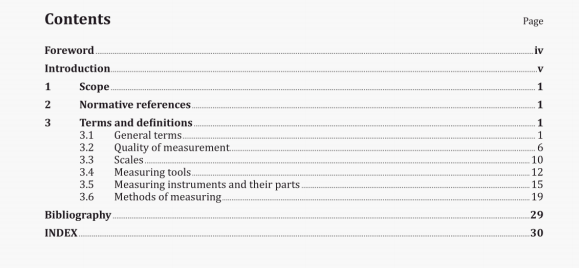ISO 7078 pdf download – Buildings and civil engineeringworks – Procedures for settingout, measurement and surveying -Vocabulary.
3.2.5
accuracy class
class of measuring instruments (11.7) or measuring systems (1L19) that meet stated mctrologlcal requirements that are intended to keep nteasurement errors (3.1.17) or instrumental measurement (3J..J.) uncertainties within specified limits under specified operating conditions
Nate Ito entry: An accuracy class is usually denoted by a number or symbol adopted by conventlon.
Note 2 to entry: Accuracy class applies to material measures.
(SOURCE: ISO/IEC Guide 99:2007,4.251
3.2.6
repeatability of results of measurement
closeness or the agreement between the results of successive measurements (ILl) of the same measurand (11.6) carried out under the same conditions of measurement
Note I to entry: These conditions are called repeatability conditions,
Note 2 to entry: Repeatability conditions include: the same measurement procedure; the same observer; the same measuring instrument (11.2). used under the same conditions; the same location; repetition over a short period of time.
Note 3 to entry: Repeatability may be expressed quantitatively in terms of the dispersion characteristics of the results.
(SOURCE: ISO/IEC Guide 98-3:2008, B.2.15j
3.2.7
reproducibility condition olmeasurement
condition of measurement (3.1.1). out of a set of conditions that includes different locations, operators. measuring systems (11.19). and replicate measurements on the same or similar objects
Note Ito entry: the different measuring systems may use different measurement procedures. Note 2 to entry: A specification should give the conditions changed and unchanged, to the extent practical. jSOURCE: lSO/IEC Guide 99:2007.2.241
3.2.8
systematic measurement error
component of measurement error (ILIZ) that in replicate measurements (3.1.1) remains constant or varies In a predictable way when the conditions change
Note I to entry: A reference quantity value for a systematic reference error isa true quantity value, or a measured quantity value of a measurement standard (3.1.14) of negligible measurement uncertainty, or a conventional quantity value.
Note 2 to entry: Systematic measurement error, and its causes, can be known or unknown. A correctfon (12.15) can be applied to compensate for a known systematic measurement error.
Note 3 to entry: Systematic measurement error equals measurement error minus random measurement error. (SOURCE: ISO/IEC Guide 99:2007. 2.17j
3.2.9
random error
result of a measurement (3.1.1) minus the mean that would result from an Infinite number of measurements of the same measurund (11.6) carried out under repeatability conditions
Note ito entry: Random error is equal to error minus systematic measurement error (ILU).
Note 2 to entry: Because only a finite number of measurements can be made, it Is possible to determine only an estimate of random error.
3.2.27
relative error
method of expressing measurement errors (3iJ1) in which %RE = I(measured value — true value (3.2.1))/true value] x 100%
Note 1 to entry: In this definition, over-estimates are positive-going errors, and underestimates are negative- going errors.
ISOIJRCE: ISO 23833:2013, 5.4.2.6, modified — The admitted terms “accuracy and %RE” have been omitted.J
3.3 Scales
3.3.1
scale
set of marks. lines or numbers, carried by the indicating device (119) of a measuring instrument (117)
Note I to entry: It Is also used In trl.angulorion (3A32) calculations.
3.3.2
spaced scale
field gradation
systematic pattern of marks, of different colours, to permit easy recognition of individual gradations
Note I to entry: Levelling stsives (3.4.7) are usually provided with spaced scales, for example E-pittern.
3-3-3
scale mark
gauge mark
line or other mark on an indicating device (ii9) corresponding to one or more delined values of the quantity measured
3.3-4
scale numbering
ordered set of numbers associated with the scale marks (113)
Note Ito entry: ISO 14978:2018. FIgure 2 Illustrates scale numbering on an analogue straight scole (3.11)
3.3-s
scale division
space on a scale (111) between any two successive scale marks (113)
Note Ito entry: Fora digital scale, the scale division is the difference between two consecutive numbers. Note 2 to entry: ISO 14978:201H, Figure 2 illustrates scale divisions on an analogue straight scale.
3.36
scale spacing
distance between two successive scale marks (113)
Note i to entry: ISO 14978:2018, Figure 2 illustrates scale spacing on an analogue straight scale (3.11).
3-3.7
scale length
Note I to entry: ISO 14978:2018. FIgure 2 illustrates scale length on an analogue straight scale (3.11).
ISO 7078 pdf download – Buildings and civil engineeringworks – Procedures for settingout, measurement and surveying -Vocabulary
